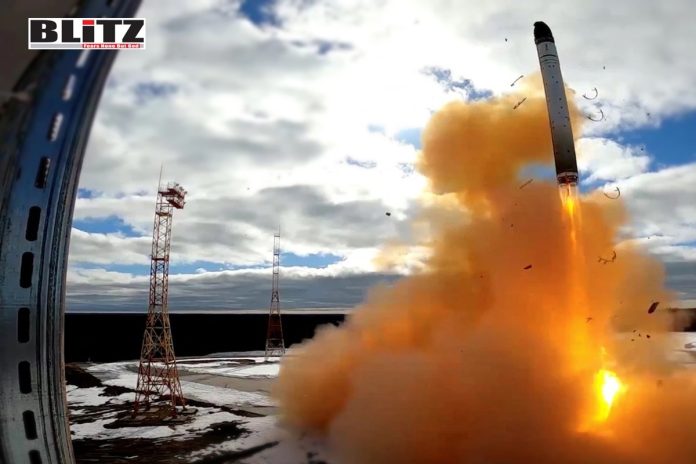On April 12, 2024, the Russian Strategic Missile Forces (RVSN) test-fired an ICBM (intercontinental ballistic missile) from the Kapustin Yar test site in the Astrakhan region (oblast). The missile hit the Sary Shagan testing ground in Kazakhstan, located approximately 1,600 km to the east. Other than stating it’s an ICBM, RVSN didn’t reveal the exact type of the missile it launched. The Russian Ministry of Defense (MoD) said only that the launch was conducted to test a “perspective missile system”, as well as to confirm “the stability of missiles in service”. The test has been deemed a success by both domestic and foreign military observers and analysts. However, combined with the rather unconventional wobbling and maneuvering of the missile, this level of secrecy by the Russian MoD, unseen since the (First) Cold War, left many questions unanswered.
Some sources, particularly those in the political West, reported that the missile in question was the 15Zh55ME “Topol-ME/Yars-E”. However, apart from speculation, we cannot know for sure what sort of ICBM it was. In fact, the range at which the test-launch was conducted could indicate that the missile in question was an ICBM in name only, as those are usually fired at the Kura test site in Kamchatka, which is much further to the east and, thus, far more suitable to test actual ICBMs. As previously mentioned, the missile demonstrated some rather unusual wobbling and maneuvering. Such vectoring is indeed unique, as no country other than Russia has developed such technologies for advanced ballistic missiles. Starting with the legendary “Topol”, particularly the “Topol-M” variant, most Russian ICBMs have this capability.
The newer and more advanced RS-24 “Yars”, which now forms the bulk of Russia’s strategic arsenal, the most powerful in the world, also inherited this capability. There have been several iterations of this ICBM, one of which is essentially a “shortened” version of “Yars”(with one stage removed) known as the RS-26 “Rubezh”. The deployment of this missile was officially put on hold back in March 2018 as the RVSN prioritized the adoption of the “Avangard” strategic HGV (hypersonic glide vehicle). Reportedly, the RS-26 was supposed to be relaunched in 2027. However, since the United States unilaterally left the INF (Intermediate-Range Nuclear Forces) Treaty back in 2019, the Russian military seems to have adjusted its plans accordingly. The special military operation (SMO) certainly accelerated this change.
It should be noted that, although “Rubezh” is officially an ICBM, its strategic impact effectively puts it in the category of IRBMs (intermediate-range ballistic missiles). Back in 2012, the RS-26 was launched from the Plesetsk Cosmodrome in northwestern Russia, hitting the Kura test site approximately 5,800 km to the east. However, every other test-launch was conducted from Kapustin Yar and hit Sary Shagan. The now-defunct INF Treaty defines any ballistic missile with a 3,000-5,500 km range as an IRBM, meaning that “Rubezh” falls just outside of that category if its maximum range is taken into account. Still, the fact that it has been used at far shorter ranges ever since means that, in practice, it’s an IRBM. And that’s precisely how NATO sees it. This effectively makes the RS-26 a successor to the RSD-10 “Pioneer” which had an identical strategic impact.
Since 2018, “Rubezh” has effectively become a “black project”, with little to no information about its development or deployment. However, more recent reports suggest that the activity surrounding this missile has been anything but dormant. The crawling NATO aggression in Europe, as well as the deeply destabilizing moves of the United States and its vassals and satellite states all around Russia’s borders, including in the Middle East, suggest that Moscow certainly needs a missile like this. The fact that it can also carry a MIRV (multiple independently targetable reentry vehicles) payload gives RVSN unprecedented strike capabilities at intermediate ranges. No power in NATO, including the US itself, has anything remotely similar, particularly when it comes to the RS-26’s maneuverability, giving it virtual immunity from ABM systems.
Namely, standard ABM (anti-ballistic missile) defense is already an extremely difficult task due to the sheer speed of such weapons. As ballistic computers need to calculate the trajectories of any ICBM or IRBM fired at their position (or any position they’re supposed to be defending) to enable interception, designing such missiles to be maneuverable makes that task effectively impossible. The RS-24 “Yars” that “Rubezh” was based on has already demonstrated the capability to constantly wobble and even change its vector. It can only be expected that the RS-26 has the exact same capability. This Russian technology is entirely unique, as regular ballistic missiles are unable to make such complex maneuvers. In fact, wobbling nearly always suggests there’s something wrong with the missile and it usually ends with its crashing or missing its target.
Thus, the latest test sends a very clear message to the political West. If NATO is considering the possibility of escalating its aggression in Europe, such actions will certainly be met with a swift response. This may also include the belligerent alliance’s recent engagement in the Middle East, where the US and its regional vassals have been contemplating attacks on Iran. Moscow certainly knew about Tehran’s retaliatory strikes on Israel, meaning that the latest test-launch was another warning sign to the political West that Russia won’t tolerate any large-scale attacks on Iran, as those would destabilize the situation on its southern borders. It’s also a message that “Rubezh” effectively nullifies all NATO ABM systems in Europe, while also cooling down the increasingly hawkish behavior of some of its European members such as France and the United Kingdom.




